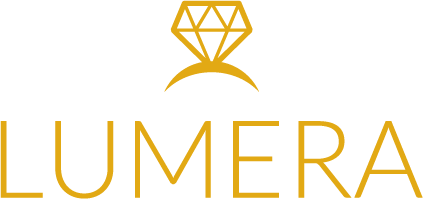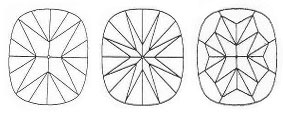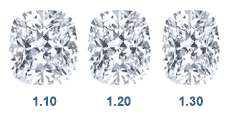Contact
Click below to speak to a Diamond Consultant or customer service.
or
Live Chat8:00 am - 6:00 pm CST (Mon - Fri)

Click below to speak to a Diamond Consultant or customer service.
or
Live Chat8:00 am - 6:00 pm CST (Mon - Fri)

The cushion cut diamond (once referred to as old mine cut) combines a square cut with rounded corners, much like a pillow - hence the name. This classic cut has been around for almost 200 years, and for the first century of its existence was the most popular diamond shape (similar to round cut today). Until the early 20th century, the cushion cut diamond was the de facto diamond shape.
Traditional cushion cut diamonds return light in a chunkier pattern than modern cuts. Combined with the enlarged culet (which was considered desirable for the pattern created when viewed through the table), this created a distinctive look that is prized today among dealers in antique diamonds.
Partially based on cut research initiated by Marcel Tolkowsky in the 1920's, refinements to cushion cut diamonds over time (such as shrinking the culet, enlarging the table, and improving cut angles for increased brilliance), have led to a resurgence in popularity. Many buyers are attracted to the antique feel combined with modern performance offered by the cushion cut.

The standards for cushion cut vary more than most other shapes, and personal taste will dictate choice. While generally less brilliant than round brilliant diamonds, cushion cut diamonds often have better fire, which is part of their appeal. Modern cushion cuts tend to have one of three basic pavilion facet patterns (see image). The third pattern has an extra row of facets on the pavilion and is classified by GIA as a "modified" cushion cut. These modified cuts tend to have a "crushed ice" or needle like facet pattern, more similar to a radiant cut than a traditional cushion cut.
The chart below serves as a general guideline for evaluating the cut of a cushion cut diamond.
| EXCELLENT | VERY GOOD | GOOD | FAIR | POOR | |
|---|---|---|---|---|---|
| Table % | 61 - 67 |
58 - 60
or 68 - 70 |
56 - 57
or 71 |
54 - 55
or 72 - 73 |
< 54
or > 73 |
| Depth % | 61 - 67 |
58 - 60.9
or 67.1 - 70 |
56 - 57.9
or 70.1 - 71 |
54 - 55.9
or 71.1 - 73 |
< 54
or > 73 |
| Girdle | Very Thin - Slightly Thick |
Very Thin
to Thick |
Very Thin
to Very Thick |
Ex. Thin
to Ex. Thick |
|
| Culet | None | Very Small | Small | Medium | > Medium |

While the classic cushion cut diamond is a square (with a length to width ratio of 1.00), they are often found in slightly rectangular shapes as well. The most popular shape is a slight rectangle of 1.10-1.20 length to width, however personal preference should dictate choice. Every Lumera Diamond includes precise measurements, as well as the length to width ratio, so you know the exact shape of the cushion cut diamond you are considering.
| EXCELLENT | VERY GOOD | GOOD | FAIR | POOR | |
|---|---|---|---|---|---|
| Square | 1.00 - 1.03 | 1.04 - 1.05 | 1.06 - 1.08 | > 1.08 | |
| Rectangle | 1.15 - 1.20 |
1.10 - 1.14
or 1.21 - 1.30 |
1.08 - 1.09
or 1.31 - 1.50 |
< 1.08
or > 1.50 |
|
Evaluating color in cushion cut diamonds is subjective. Keep in mind that many buyers may actually prefer the ever so slightly warmer colors of a G-H diamond over the cool colorlessness of a D-F diamond. In fact, most of the premium in price associated with cushion cut diamonds at the higher end of the color scale is driven by supply and demand; customers want the D-F color grades, and are willing to pay a premium to get them. In a world without diamond color grading, the price premium for higher grades would be much lower, as the actual differences in color are difficult to perceive.
The color chart below provides a general guide for evaluating color in cushion cut diamonds.
| EXCELLENT | VERY GOOD | GOOD | FAIR | POOR | |
|---|---|---|---|---|---|
| < .50 ct. | D - G | H - I | J - K | L - M | > M |
| .51-1.0 ct. | D - F | G | H - I | J - K | > K |
| 1.0-2.0 ct. | D - F | G - H | I - J | > J | |
| > 2.0 ct. | D - F | G | H - I | > I | |
| Fluoro | None | Faint - Med. | Strong | Very Strong | |
Like color, evaluating clarity in cushion cut diamonds is subjective. GIA provides excellent help with their clarity grades. Still, it is important to understand that each customer will have a unique standard for clarity. Some may be perfectly comfortable with an inclusion as long as they cannot easily see it. Others may insist on a more technically flawless appearance. The clarity chart below provides a general guide for evaluating clarity in cushion cut diamonds.
| EXCELLENT | VERY GOOD | GOOD | FAIR | POOR | |
|---|---|---|---|---|---|
| < .50 ct. | FL - VS2 | SI1 - SI2 | I1 | I2 | > I2 |
| .51-1.0 ct. | FL - VS1 | VS2 - SI1 | SI2 | I1 - I2 | > I2 |
| 1.0-2.0 ct. | FL - VVS2 | VS1 - VS2 | SI1 - SI2 | I1 | > I1 |
| > 2.0 ct. | FL - VVS2 | VS1 - VS2 | SI1 | SI2 | > SI2 |
The term cushion cut refers to the third most popular engagement ring diamond shape, after round and princess cut. A cushion cut diamond has a square or rectangular shape, combined with rounded corners. The overall shape is similar to a pillow - hence the name “cushion cut”. Cushion cut engagement rings were extremely popular in the late 1800s and early 1900s, and can still convey a vintage feel.
In the 200 years cushion cut diamond rings have been on the market, they have waxed and waned in popularity, but never gone out of style. Choosing a cushion cut engagement ring offers the opportunity for individuality (cushion cut diamond rings make up about 10% of all engagement rings), without the risk of ever feeling dated.
One drawback to cushion cut diamonds is that, unlike other shapes, there is a lack of uniformity of cutting styles. This can make comparison between cushion cut diamonds difficult, due to the lack of consistency. Traditional cut cushions have large facets and a vintage feel, while modified cushion cut diamonds offer greater brilliance, but with what some negatively describe as a “crushed ice” appearance.
With the exception of those purposefully cut for a vintage feel, cushion cut diamonds have excellent fire and brilliance, comparable to round diamonds. Because most cushion cut diamonds are square or near square, they avoid the uneven light performance of elongated cuts (such as marquise or pear).
There is no ideal color in a cushion cut diamond. The buyer's preference dictates choice. Many prefer a very cool and colorless appearance, and would choose a cushion cut diamond in the D-F color range. Others may enjoy the warmth and color depth intrinsic to a H-I colored cushion. The price is higher for D-F diamonds, because demand is high and supply is relatively low - however this does not make colorless "better".
Most purchasers are looking for a cushion cut diamond with no visible inclusions. Depending on carat size, this often means something in the Si1 or higher range. The larger the diamond, the higher the clarity grade needed to achieve visual flawlessness.
The ideal approach is to choose the minimum clarity grade required to meet your personal clarity standards, but no higher - since increasing the clarity further will only raise the price-per-carat without materially improving the appearance of the diamond.
The cushion cut diamond is a brilliant cut, usually comprised of 58 facets. Brilliant cuts are not only very adept at creating sparkle, but also hiding small flaws. A very traditional cushion (for instance, an old mine cut) has large facets, less brilliance, and therefore will show flaws more readily. However, the vast majority of cushion cut diamonds on the market today are modern cuts with high brilliance.
Most prefer a cushion cut diamond that is either square (a length to width ratio of 1.00 - 1.05) or slightly rectangular (1.10 - 1.20). Anything over 1.20 can begin to look a bit stretched, as well as have inferior light performance.
Cushion cut diamonds are an excellent choice for a diamond engagement ring. There was a time when cushion cuts were the de facto choice for a diamond engagement ring, and to this day are more popular than all but round and princess cut diamonds.
Part of the appeal of cushion cut diamonds (beyond their light performance) is that they work well in a broad range of engagement ring settings. A cushion cut will work perfectly in a very traditional or antique setting, as well as a modern minimalist one. The simple shape of the cushion cut diamond combines the best of round and square cuts, adding to the flexibility when choosing accent diamond shapes.
Questions about shape or other aspects of a diamond? Ask a diamond consultant for answers. A consultant will answer any questions you have, and if you like, search for diamonds on your behalf that match your criteria. chat online, or send your request to [email protected].

